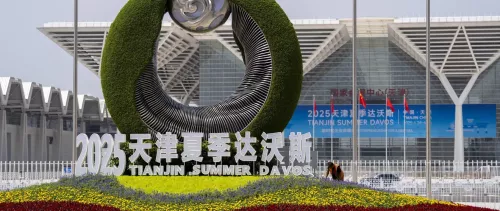
Closing the gap. Image: REUTERS/Regis Duvignau
The World Economic Forum's latest Agenda Dialogues looked at the challenge of closing the digital divide and ensuring equitable access to the opportunities that internet connectivity affords.
Taking part were: Paula Ingabire, Minister of Information and communications technology and Innovation of Rwanda; Omar bin Sultan Al Olama, Minister of State for Artificial Intelligence, Digital Economy and Remote Work Application of the United Arab Emirates; Achim Steiner, Administrator, United Nations Development Programme; Tan Hooi Ling, Co-Founder, Grab; Robert F. Smith, Founder, Chairman and Chief Executive Officer, Vista Equity Partners; Adrian Lovett, President and Chief Executive Officer, World Wide Web Foundation.
The session was chaired by Børge Brende, President, World Economic Forum, and moderated by Adrian Monck, Managing Director, World Economic Forum.
COVID-19 a 'catalyst' for digital transition
The COVID-19 pandemic has accelerated the digital transition, all the panelists agreed. As Paula Ingabire explained, it's been a 'catalyst' for digital transformation in many countries - both in fighting the pandemic and using digital tools to ensure essential services could continue.
But a digital divide and disparities persist, she added, and the current pace of digital adoption is exaggerating this divide.
And while technology helped tackle many of the challenges thrown up by the pandemic, there are broader issues still to tackle, explained Omar bin Sultan Al Olama. It's not enough to just give a child a tablet - you need to ensure their learning environment is appropriate, he said.
Access, in spite of the acceleration we've seen during the pandemic, remains a major hurdle though, the panel agreed.
A whole-society approach
Inclusion needs to be at the centre of the digital transformation, urged Achim Steiner. You need to consider society as a whole, he said. You need to build digital ecosystems that work for start-ups, for entrepreneurs, for coders and programmers, but also ensure people aren't left behind.
Connection alone isn't enough. Steiner asks: How can we build education systems that will allow young people to thrive in digital economies?
And meaningful connections are important, urged Ingabire and Adrian Lovett. It's not binary said Lovett - whether you're connected or not - it's about ensuring people have infrastructure they can rely on and a connection they can access regularly.
The potential of closing the gap
There are enormous opportunities if we can close the divide, from education to employment. There's 'massive economic impact' in uplifting communities, if we can take advantage, summarized Robert F. Smith.
And as Lovett explained, the returns on investment are significant - we just need the resources.
How GDP grows with increased connectivity. Image: Tony Blair Institute for Global Change
Digital technology also helped those who suffered the disruption caused by the pandemic, said Tan Hooi Ling. Her technology company Grab was able to offer a lifeline to many who had seen other forms of income disappear, she said.
"The economics of this works," summarized Al Olama. We just need people to understand the potential and to encourage the public and private sector to work together to convince investors.
The role of public-private partnerships
The panelists were united on the need for collaboration between the private and public sectors - and civil society, added Lovett.
The involvement of the private sector is already driving progress in the United States, explained Smith. There are already various initiatives underway to improve connectivity in communities around the country. And it's important that US businesses are encouraged to engage with the public sector.
This is true across the world, explained Tan. As a social enterprise, Grab asks itself how can it work together with other companies and with governments to create products and services that are really needed.
A "unified effort" is needed from the public and private sectors, believes Al Olama.
It's not a question of how one is better than the other, concluded Steiner. It's a question of how one can enable the other.
The World Economic Forum's EDISON Alliance is focused on ensuring everyone across the globe is able to affordably participate in the digital economy. You can read more about it here.


